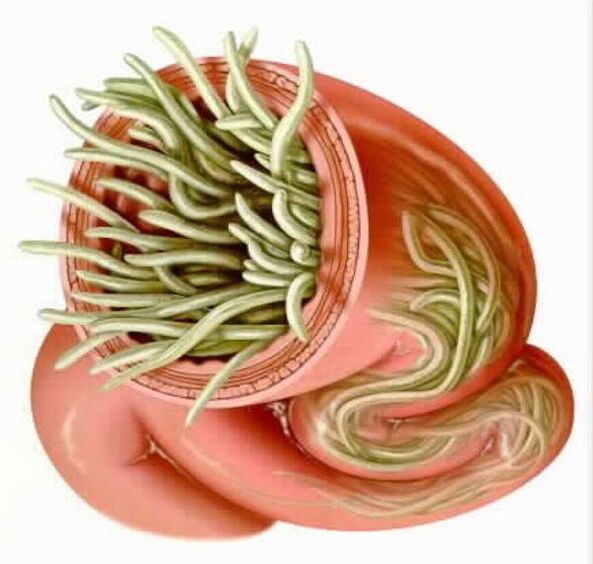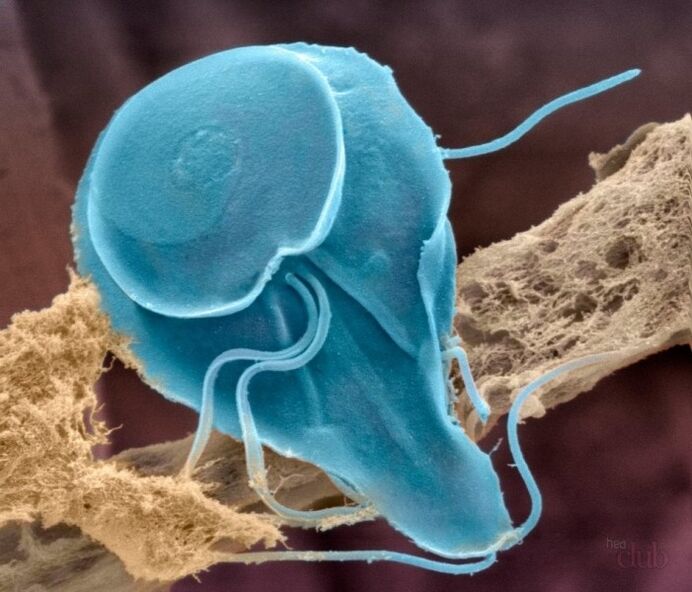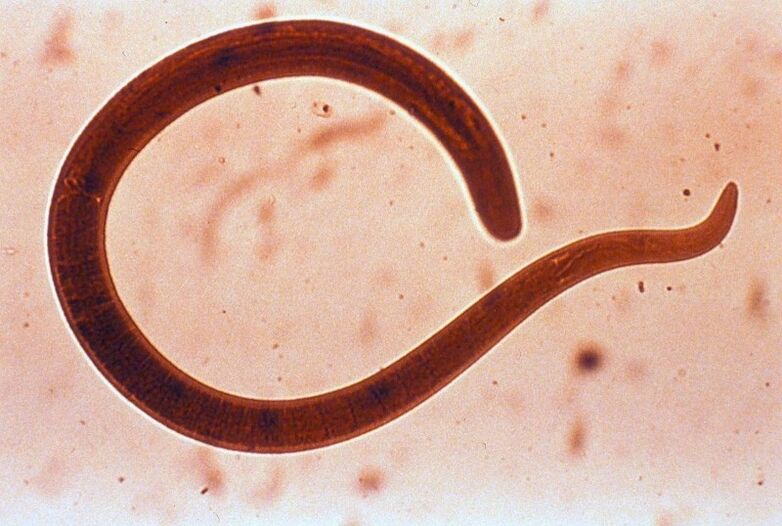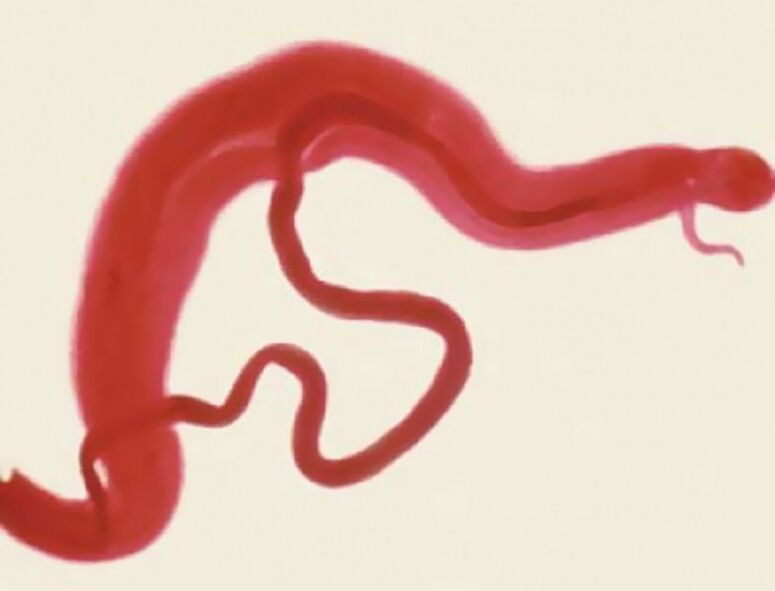Parasites in the human bodyappear completely unexpectedly. This is usually due to direct contact with a source of infection, such as an infected person or object. There are many types of parasites that can be found in the human body: lamblia, pinworms, alveococci, trichinella, schistosomes, etc.
Parasites in the human body

The human body has a very complex structure that is sensitive to various diseases and infections, infections, viruses and parasites. Parasites inhabiting the human body, other organisms, microorganisms, cells, etc. are parasitic microorganisms that try to survive by feeding on
Parasites living in the human body, other organisms, microorganisms, cells, etc. Parasites that try to survive by feeding on are microorganisms that lead a sedentary lifestyle.
Parasites, which find a fertile ground for life and reproduction in the human body, cause very serious, sometimes irreparable damage to his health, destroy the body from within, eat it and sometimes cause the death of a person or the work of individual organs, whichworsens, depresses and, as a result, shortens life.
There are millions of parasitic worm species in nature. Of these, there are those that parasitize only one member of the animal kingdom. However, there are several species of animals in nature that can exist in the body. The fact that parasites live in the human body is a question asked by many people.
There are many types of helminths that can live in the human body. Some are very rare, while others inhabit the interior very often and can lead a parasitic lifestyle for several decades.
Types of parasitism
There are the following types of parasitism: ectoparasitism - parasites that lead a superficial lifestyle in the human body. This category includes lice, insects, and ticks; endoparasitism - parasites that affect the internal organs of man. They, in turn, are divided into two large groups of protozoa and helminths.
Parasitic protozoa species: lamblia, toxoplasma, trichoionada. This type of protozoan parasite is most common in the human body.
Classification of parasites associated with helminths involves their division into three major groups: nematodes; trematodes; cestodes.
Types of parasites in the human body
Pinworms
Pinworms are the most common parasites in the gut. The disease caused by pinworms is called enterobiasis. Not only humans, but also great apes. The risk of pinworm infection increases in children. According to various sources, the level of their involvement in enterobiasis in preschool age varies between 25-90%. Pinworms are transmitted from one person to another. Infection occurs through handshakes, clothing, and anything that touches a sick person, hands should not be washed after contact, and lungworm eggs should not fall into the mouth (especially during eating).
Flies and cockroaches can lay their eggs by feeding on the food of these nematode worms. Pinworms live in the small intestine, intestines, colon. They mate in the intestine, after which the female leaves the anus and lays an egg in the anus.
Symptoms of enterobiosis include itching in the anal area, intoxication (allergic reactions, exhaustion, fatigue), anemia, increased levels of eosinophils in the blood, insomnia and abdominal pain.Anthelmintic drugs are used to get rid of enterobiosis. The dosage and course of treatment is chosen by the doctor, keep your hands clean to avoid re-infection, after going to any public place, after using the toilet, before eating, etc.
Nails should be cut short, bedding and underwear should be thoroughly disinfected and the apartment should be cleaned daily.
Toksokara
Toxocara is a parasite from the nematode group. The disease caused by toxocara is called "toxocariasis". In humans, this invasion can occur in the gut as well as in the larva (eye and visceral). The disease is widespread throughout the world. Toxocara infection occurs when worm eggs enter the human digestive system. This is most often seen when eating food or water contaminated with dog feces. Contact with sick animals is less dangerous.
The natural carriers of toxocara are cats and dogs, foxes and worms. After entering the human body, the larvae migrate through the blood vessels and can be located in any organ. The symptoms of the disease will depend on it. Toxocariasis often manifests itself in the form of allergic reactions (Quincke's edema, skin rash, bronchial asthma). During the exacerbation of the disease, the body temperature may rise to 38 degrees, but the symptoms of intoxication are weakly expressed.
Toxocariasis can be suspected of enlarged lymph nodes: the visceral form of toxocariasis is the most common, occurring with damage to internal organs (intestines, respiratory system, heart valves).
A person may have pain in the abdomen, right hypochondria, dyspeptic disorders, nausea; If the respiratory system is damaged, a person has shortness of breath, dry cough, choking attacks; if toxocars are located in the heart valves, the patient has weakness, blue fingers and nasolabial triangle, shortness of breath; skin form is characterized by itching, a feeling of movement under the skin, inflammation of the skin and mucous membranes; In the neurological form, the parasite causes inflammation of the brain and brain tissue.
Manifested in headache, nausea and vomiting, convulsions and other neurological diseases. In addition to pathogenetic and symptomatic therapy, anthelmintic drugs are used to treat toxocariasis.
Human Ascaris
Human Ascaris is a roundworm that parasitizes the small intestine. The disease caused by these parasites is called ascariasis. The owner of the roundworm and the source of infection is a sick person. Along with their feces, the worm's eggs enter the soil and reach the larvae. This soil is then given to food or human hands, and if the rules of personal hygiene are not followed and fruits, vegetables and berries are poorly processed, they are transferred to the digestive system.
Children and villagers are more susceptible to infection. Ascariasis manifests itself in different ways at different stages of development. During the migration of larvae in the body, there is an increase in body temperature, a dry cough appears, wheezing and lymph nodes grow in the lungs. Children suffer more from ascariasis than adults.
Allergic skin reactions are a characteristic feature of ascariasis. During intestinal parasitism, the patient develops dyspeptic disorders, empty stools are replaced by constipation, and often abdominal pain, nausea and vomiting occur. Hysterical seizures, insomnia, mental fatigue and headaches are observed by the nervous system.
In the stage of larval migration, patients are prescribed some anthelmintic drugs to treat ascariasis, while others are parasitized by worms in the intestines.
Ankilid worm and nekator
Ankylosturus and nekator are two types of roundworms belonging to the family Ancylostomatidae, which cause a disease called ankylosing spondylitis. There are two ways of infecting the human body with these parasites - fecal-oral (drinking contaminated water, fruits, vegetables) and percutaneous in contact with soil (penetration occurs through the skin).
Clinical symptoms of hookworm: papular vesicular rash, shortness of breath and cough, loss of appetite, nausea, abdominal pain, loose stools, iron deficiency anemia. Treatment is reduced by taking anthelmintic drugs and eliminating anemia with iron supplements.
Wide Ribbon
The broad-leaved tapeworm is a tapeworm of the genus Pseudophyilidea. These parasites live in the small intestines of humans and fish-eating mammals. Infection with a tapeworm causes the development of a disease such as diphyllobothriasis.
There are 12 types of tapeworms that can parasitize the human body, with the widest tapeworm being the most common. Infection occurs when eating raw and thermally processed small amounts of salted fish or caviar with worm eggs. Symptoms of the presence of parasites in the intestines: nausea, abdominal pain, anemia.
In severe cases, intestinal obstruction develops. Patients are prescribed antiparasitic drugs to get rid of the parasite. After completing the therapeutic course, a second work is mandatory for the presence of a worm in the body. If necessary, the use of anthelmintic drugs is repeated.
Bull lenteworm
Bull tapeworm is a tapeworm of the teniid family. It affects cattle in the larval stage and lives in the human body (intestines) during the tapeworm stage. Black worms cause a disease called teniarinhoz, usually a parasite in the patient's body. Human infection occurs through eating after eating low-heat processed meat (beef).
Clinically, the disease manifests itself with nausea, excessive appetite, abdominal pain, unstable stools and allergic reactions such as urticaria. An anthelmintic agent is prescribed to remove the cow's tape from the body. In parallel, the patient should follow a diet without slag, put a cleansing enema, take a laxative. After using an anthelmintic agent, the worm dies and leaves the human body naturally. Sometimes it can be up to 12 m long.
Pig tapeworm
The pork worm is a tapeworm that is a parasite that infects mammals. Intermediate carriers can be pigs, dogs, rabbits, camels, but the final owner is always a human.
If there is an adult parasite in a person's body, then they talk about a disease like teniasis. When the parasite is in the patient's body during the larval stage, the disease is called "cysticercosis".
Pork lenteworm infection occurs when eating unprocessed pork. Sometimes the sources of cysticercosis are semen or water. A patient with teniasis poses an epidemiological threat to himself (infection by larvae of the brain, skin, eyes or skeletal muscles) and to others.
Symptoms of teniasis: abdominal pain, loss of appetite, bowel movements, headache, frequent dizziness, fainting (teniasis in the brain and eyes is extremely dangerous). The patient is hospitalized for the treatment of teniasis. Under the supervision of doctors, he is prescribed anthelmintic drugs, after 2 hours the patient takes a saline laxative, which allows him to get rid of worm segments and eggs. Surgery is needed to treat eye and brain cysticercosis.
Echinococcus
Echinococcus is a tapeworm belonging to the order Cyclophyllidae. Adults parasitize in the intestines of dogs and cats, and in jackals and wolves. Parasitic larvae are dangerous to humans, which can lead to a serious disease - echinococcosis. Larvae can infect a person's internal organs, forming echinococcal cysts. For echinococci, humans act as an intermediate host.
Infection is transmitted through contact (in the process of cutting carcasses, interacting with a sick animal) or through food (eating contaminated food or water). The risk group is people who are engaged in animal husbandry or are in constant contact with animals. Symptoms may not appear for many years.
At the end of the asymptomatic stage, pain, itchy skin and urticaria appear at the site of larval capture. In addition, the organ parasitized by echinococcus larvae suffers. An increase in body temperature is observed during the washing of the cyst.
Complete treatment of echinococcosis is possible only with surgery. The cyst peels off, taking care not to damage the skin. If the bladder is too large, it is punctured and the substances inside are absorbed. Before and after the operation, the patient is prescribed antiparasitic drugs. In the case of radical removal of the cyst, the prognosis of recovery is favorable.
Alveococcus
Alveococcus is a helminth from the cestode group. The worm cries out for a life-threatening disease of alveococcosis, characterized by the formation of primary foci in the liver with the spread of metastases to other organs. Infection occurs when the oncospheres of the parasite enter the mouth.
This can happen when hunting, cutting the carcasses of wild animals, coming in contact with pets, or eating unprocessed berries and grass from the forest. Symptoms of alveococcosis are reduced to pain in the right hypochondrium, belching, nausea. There are frequent itching, allergic reactions. It is not ruled out that a tumor may be parasitized and thrown into the abdomen or pleural cavity.
Alveococcal metastases are found in the brain and lungs. Treatment of the disease is early, but should be completed with antiparasitic drugs.

Giardia
Giardia (another name for Giardia) are flagellar parasites of the Diplomonadide family. Giardia causes a disease called "giardiasis" and parasitizes many other mammals in humans and even the small intestine of birds.
Giardia infection occurs through fecal-oral route: food, water and contact-home methods. The greatest importance in terms of transmission of infection is the use of raw water, contaminated food, the use of public utensils sown with lamblia cysts. The leading symptoms of giardiasis are nausea, abdominal pain, stool discomfort, and excessive gas.
In addition, patients suffer from allergic reactions, intoxication and neurotic disorders. Giardiasis therapy is carried out with the help of antiprotozoal drugs, as well as the inclusion of enzymes, choleretics and enterosorbents in the treatment regimen.
Histology of amoeba
Histological amoeba is a protozoal parasite that causes a disease called amoebiasis. The disease manifests itself in the formation of ulcers in the large intestine, followed by damage to other internal organs. Infection with amoebas occurs orally, after adult cysts from water or food enter the human gastrointestinal tract. Transmission of parasites from unwashed hands by possible contact. Flies can be carriers of amoebas.
Another way to spread ambiasis is through sexual intercourse (anal intercourse). Symptoms of ambition: heavy mucous stools, abdominal pain, blood in the stool, weight loss, anemia. In addition, extra-intestinal amemiasis is characterized by the formation of abscesses in organs affected by parasites (lungs, brain, liver, etc. ).
Antiprotozoal drugs are prescribed to treat intestinal ambiasis.
The duration of therapy is determined by the severity of amoebiasis.
A disease called gnatostomosis is caused by larvae and sexually mature nematodes Gnathostoma spinigerum. Infection occurs when eating raw fish, frogs or poultry, and drinking unboiled, unpolluted water. Symptoms include coughing and pain, local inflammation, and an increase in body temperature where the larvae penetrate the skin.
Severe edema and itching are typical. As a rule, the symptoms disappear within a week after the onset, but recur over the years. Dangerous damage to the eyes and brain, often fatal. Treatment consists of taking anthelmintic drugs and surgery. During the operation, the parasites are removed from under the skin.
Trichinella

Trichinella are round parasitic worms that live in the muscles of the larval stage (oculomotor, masticatory, diaphragm muscles) and in adulthood - in the lumen of the small intestine. The disease caused by Trichinella is called "trichinosis". It's deadly.
Human infection occurs as a result of the use of raw or poorly processed meat from wild and domestic animals. Symptoms include loss of appetite, vomiting, diarrhea, and abdominal pain. In the future, muscle pain, swelling of the eyelids and skin rashes are combined. Treatment of parasitic heat is carried out with the help of anthelmintic drugs. At the same time, antihistamines and corticosteroids are prescribed if necessary.
Schistosomes
Schistosomes are winged worms of the genus Trematode. They cause a disease called Schistosomiasis. Human infection occurs during bathing, washing clothes, or irrigating the area with schistosomiasis larvae. They can penetrate the human body, even from the whole skin and mucous membranes. Symptoms in the acute phase of the disease include fever, itchy skin, and papules all over the body.
They can penetrate the human body, even from the whole skin and mucous membranes. Symptoms in the acute phase of the disease include fever, itchy skin, and papules all over the body.
After the disease becomes chronic, the infected person develops colpitis, prostatitis, colitis, ascites, hydronephrosis, etc. may show signs. Anthelmintic drugs are used to treat the disease. Complications of genitourinary schistosomiasis require surgery.
There are many parasites that can harm the human body. Most of it enters the owner's body from the gastrointestinal tract if safe food preparation technology is not followed and basic hygiene procedures are not followed.
Parasites in the body - adaptation features
- longevity (helminths live in the human body for years and sometimes during the life of the parasite host);
- the ability of the host organism to suppress or alter the immune response (immune deficiency occurs, conditions are created for the penetration of pathogenic agents from the outside, as well as for "disinfection" of internal sources of infection);
- Many helminth species that enter the digestive system release anti-enzymes that save them from death; digestive process is disturbed, various severe toxic-allergic reactions appear: urticaria, bronchial asthma, atopic dermatitis;
- developmental stages (eggs, larvae, change of owners);
- ability of eggs to live in the external environment for years;
- where the exchange of genetic information takes place, and this is already the highest stage of development and leads to an increase in the heterogeneous population, ie parasites are less susceptible;
- Lack of immunization methods due to weak and unstable immune response;
- widespread helminths, many habitats (water, soil, air, plants and animals).
Prevention of parasites in the body
Preventive measures to prevent the spread of parasites should be comprehensive. First of all, it is necessary to follow the rules of personal hygiene, eat only washed fruits and vegetables, as well as cooked fish and meat, drink only clean water.
Most experts advocate the prevention of helminthiasis using pharmaceutical antiparasitic drugs - a parasitologist will help you choose the right drug and calculate the correct dose.
You can supplement this therapy with folk remedies that have an anthelmintic effect - for example, eat more onions, garlic, various spices, eat pumpkin seeds regularly.
























